Abstract
Favism is a potential obstacle to the use of the fava bean in the development of a locally produced, inexpensive weaning food for the Middle East and North Africa. The purposes of this study were to define the epidemiology of favism, to evaluate the advisability of using the fava bean in a weaning food, and to suggest ways of avoiding or eliminating the toxic factor in the bean. Field observations, locally acquired data, and a literature review suggested that the use of the fava bean in a weaning food would be hazardous, but that the hazard might be overcome by using certain strains of the bean or, more particularly, by using old dried beans. The disease is usually directly related in time to the harvesting and availability of fresh beans, but it is also associated with fresh dried beans. On the basis of the age distribution of the disease, patterns of bean consumption, and local food taboos it appears that the toxic factor is concentrated in the skin of the bean, that it is heat-stable, that in dried beans it decreases with age, and that it crosses into the breast milk of lactating mothers. It also appears that disease expression may be a result of the interaction of several host factors, such as nutritional status and the consumption of other foods. These observations are consistent with the results of laboratory studies, which incriminate vicine, divicine, and DOPA in the etiology of favism.
Full text
PDF
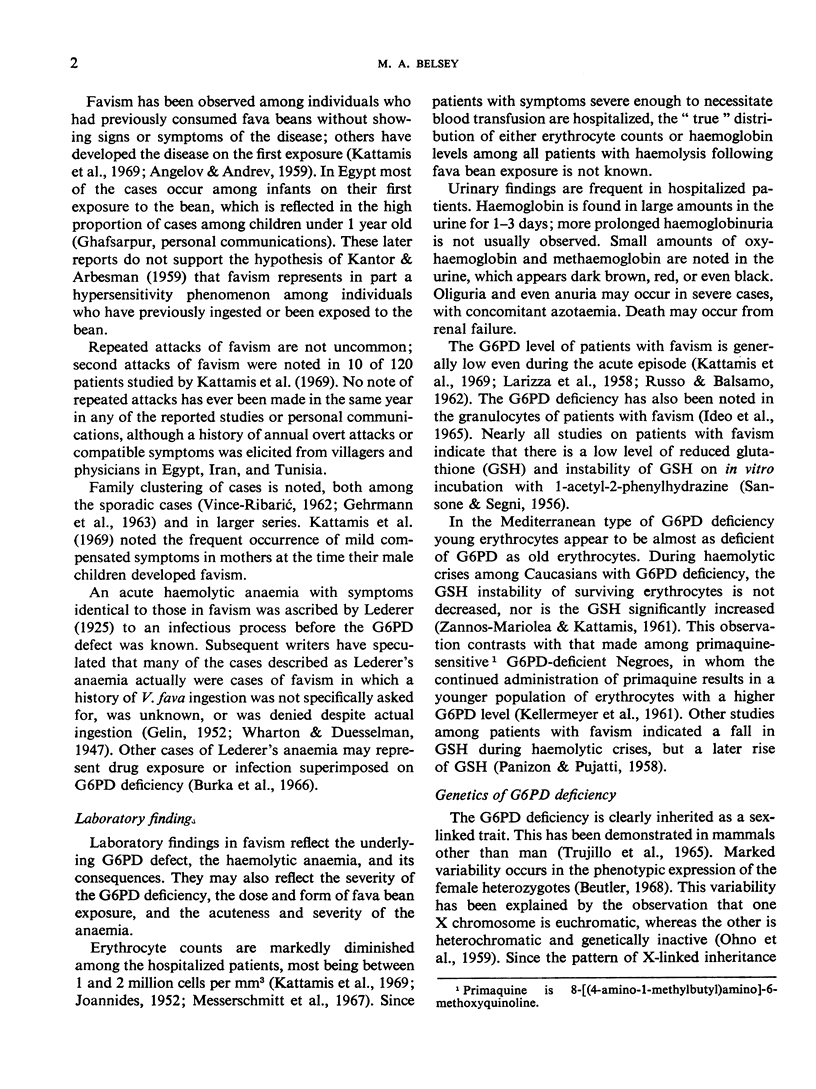
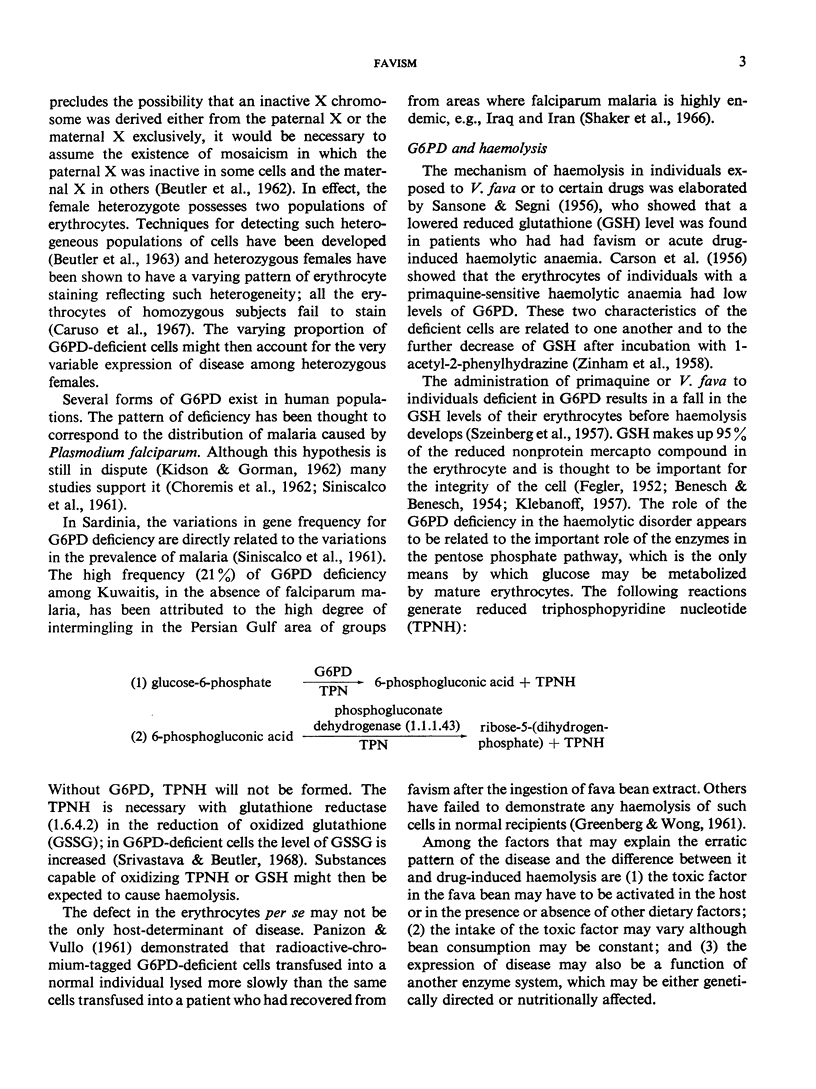
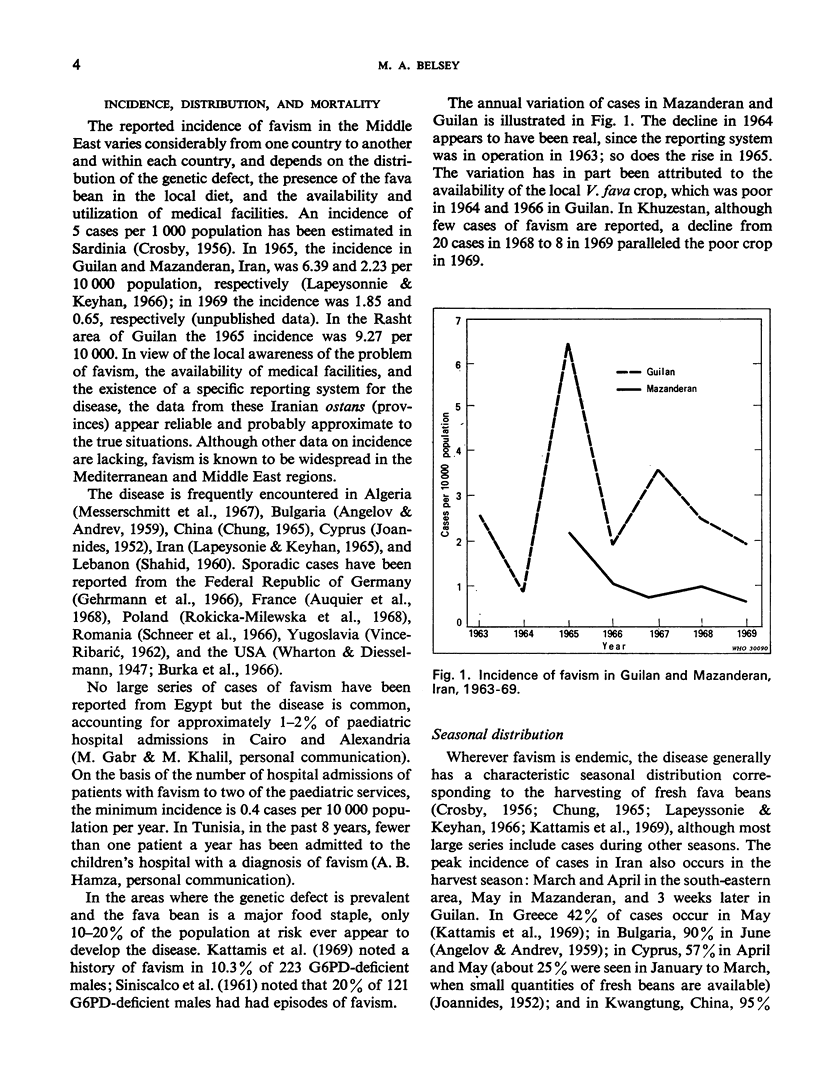

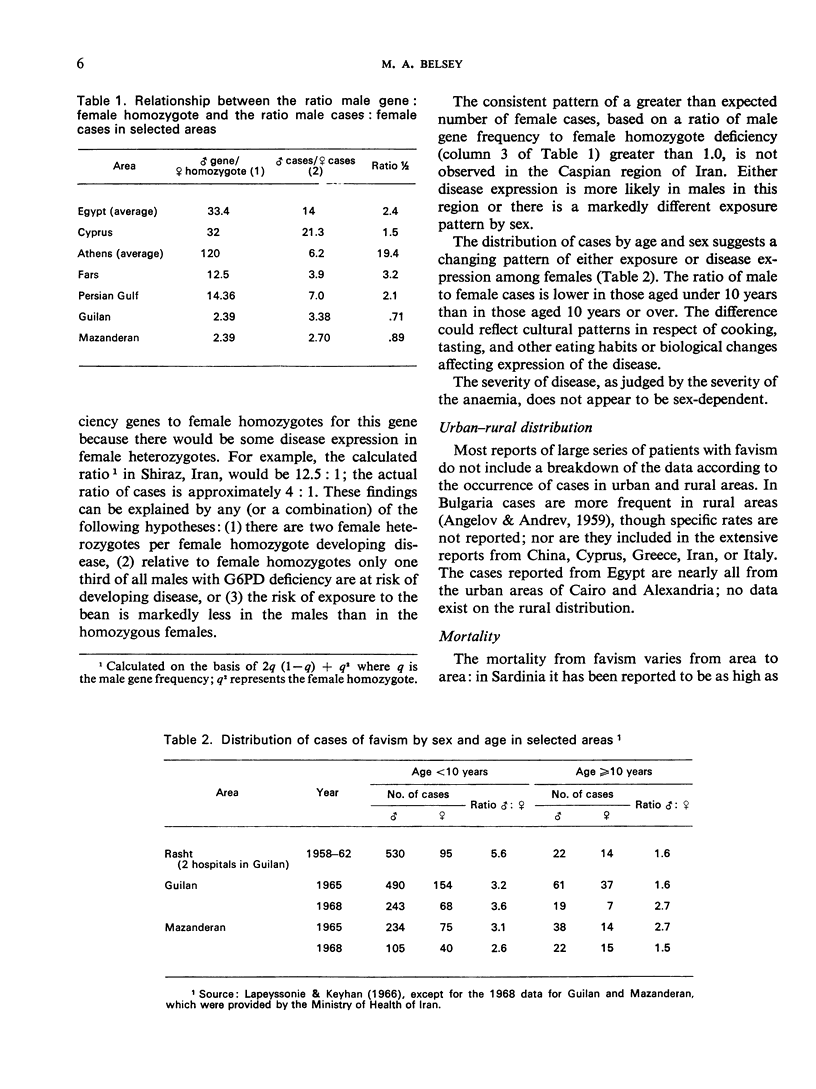
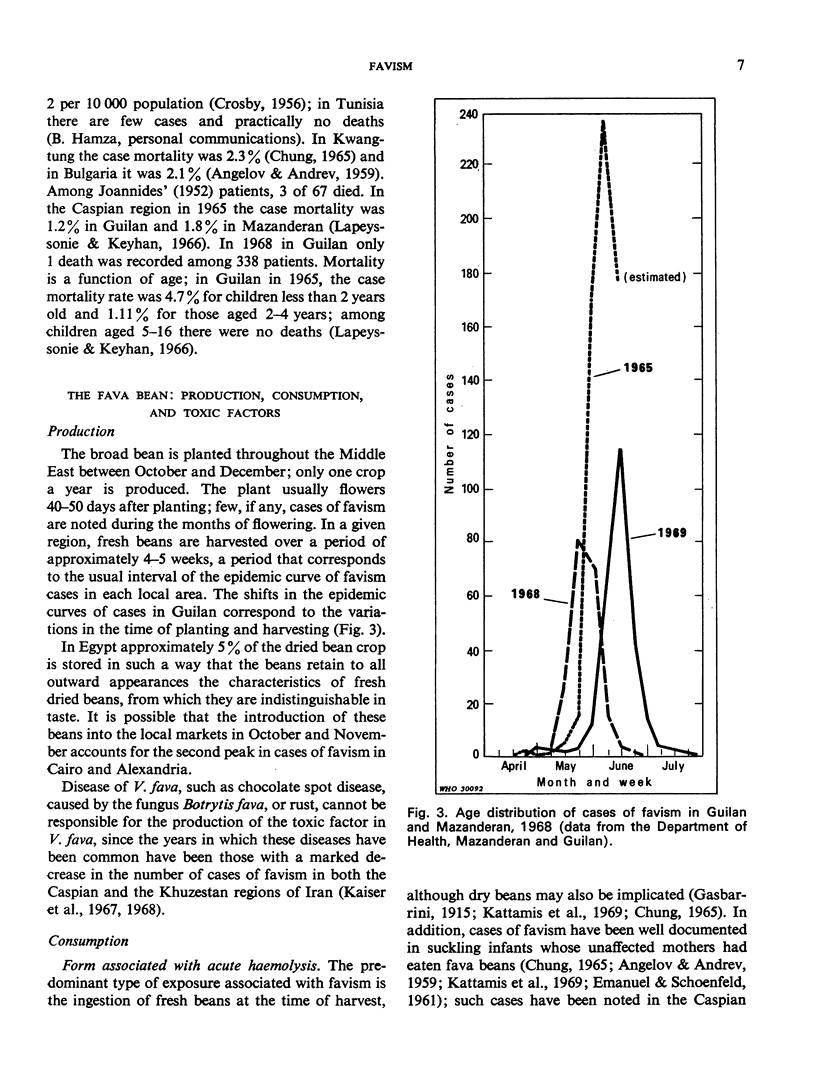
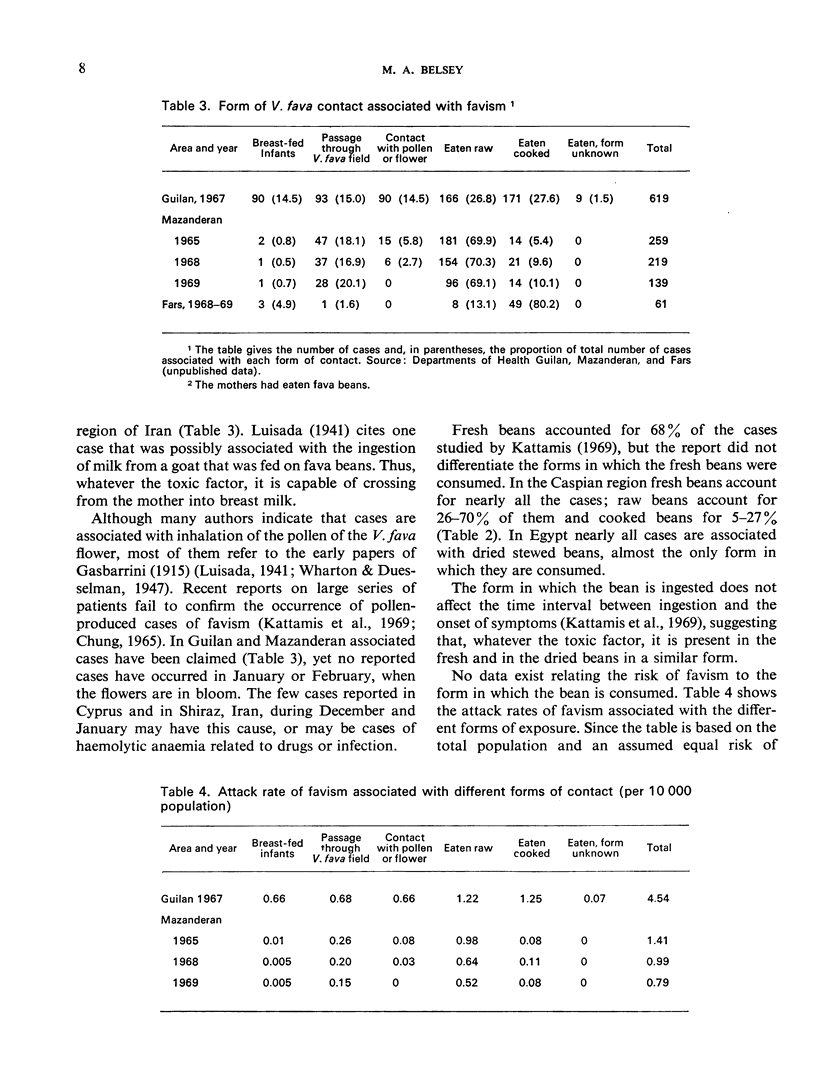
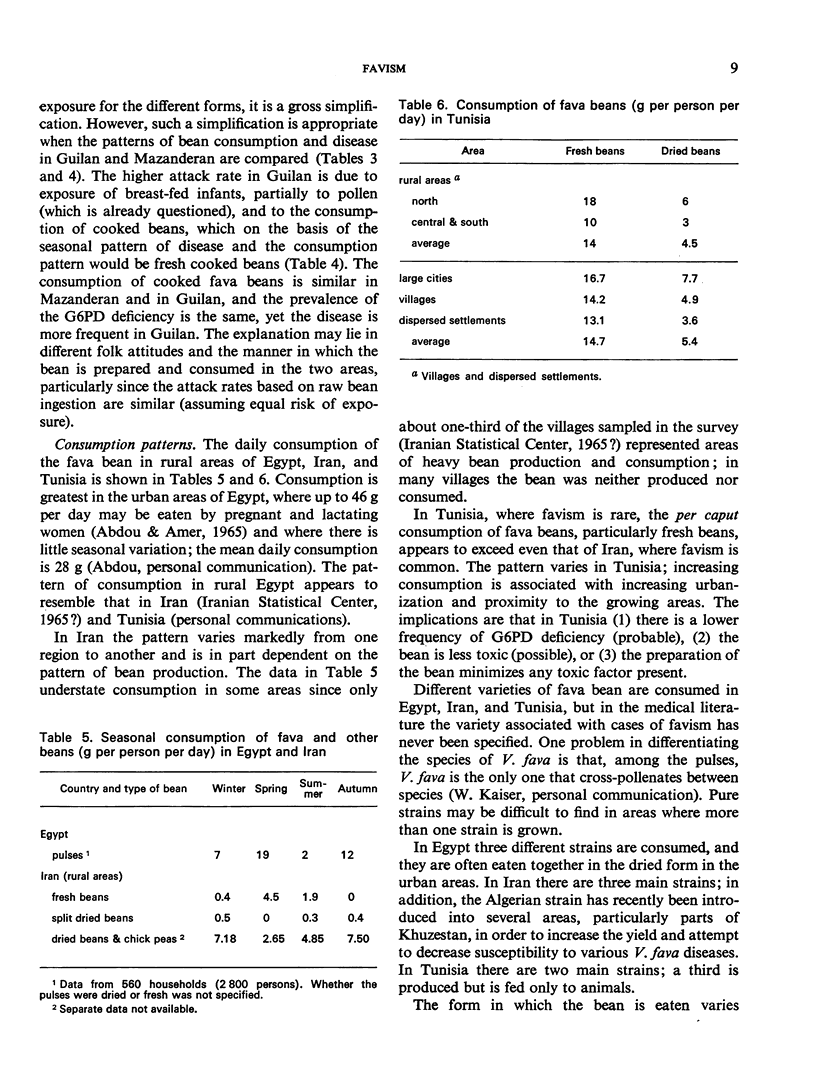

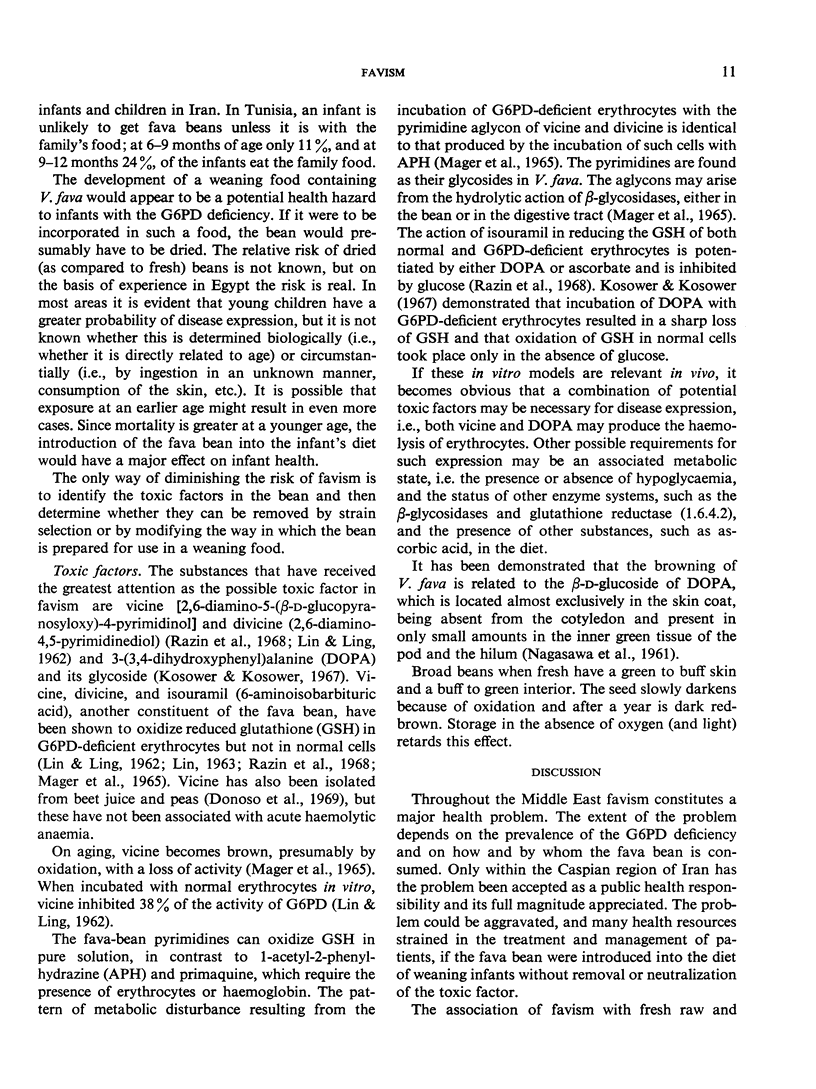

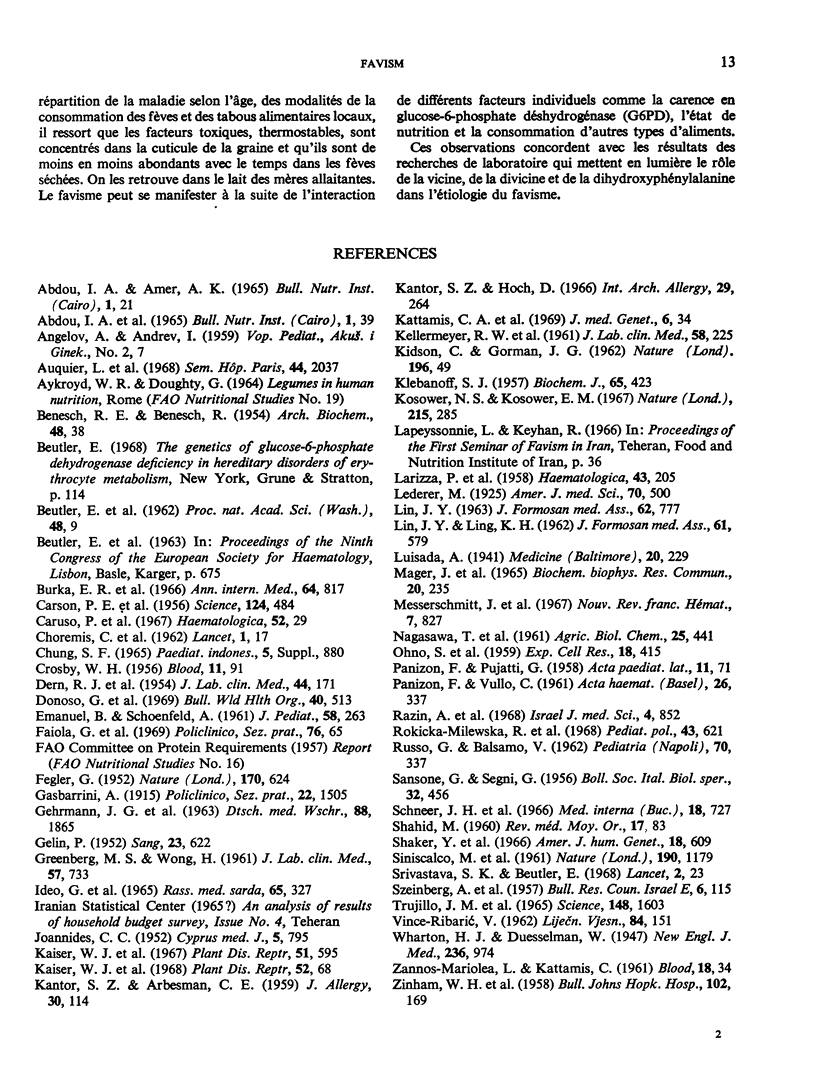
Selected References
These references are in PubMed. This may not be the complete list of references from this article.
- ALVING A. S., CARSON P. E., FLANAGAN C. L., ICKES C. E. Enzymatic deficiency in primaquine-sensitive erythrocytes. Science. 1956 Sep 14;124(3220):484–485. doi: 10.1126/science.124.3220.484-a. [DOI] [PubMed] [Google Scholar]
- BENESCH R. E., BENESCH R. Relation between erythrocyte integrity and sulfhydryl groups. Arch Biochem Biophys. 1954 Jan;48(1):38–42. doi: 10.1016/0003-9861(54)90302-1. [DOI] [PubMed] [Google Scholar]
- BEUTLER E., YEH M., FAIRBANKS V. F. The normal human female as a mosaic of X-chromosome activity: studies using the gene for C-6-PD-deficiency as a marker. Proc Natl Acad Sci U S A. 1962 Jan 15;48:9–16. doi: 10.1073/pnas.48.1.9. [DOI] [PMC free article] [PubMed] [Google Scholar]
- CHOREMIS C., ZANNOS-MARIOLEA L., KATAMIS M. D. Frequency of glucose-6-phosphate-dehydrogenase deficiency in certain highly malarious areas of Greece. Lancet. 1962 Jan 6;1(7219):17–18. doi: 10.1016/s0140-6736(62)92640-5. [DOI] [PubMed] [Google Scholar]
- Caruso P., Ciliberto R., Mazzaglia E. Attività G6PD-asica in omo- ed eterozigoti. Haematologica. 1967;52(1):29–40. [PubMed] [Google Scholar]
- DERN R. J., BEUTLER E., ALVING A. S. The hemolytic effect of primaquine. II. The natural course of the hemolytic anemia and the mechanism of its self-limited character. J Lab Clin Med. 1954 Aug;44(2):171–176. [PubMed] [Google Scholar]
- Donoso G., Hedayat H., Khayatian H. Favism, with special reference to Iran. Bull World Health Organ. 1969 Apr;40(4):513–519. [PMC free article] [PubMed] [Google Scholar]
- EMANUEL B., SCHOENFELD A. Favism in a nursing infant. J Pediatr. 1961 Feb;58:263–266. doi: 10.1016/s0022-3476(61)80166-2. [DOI] [PubMed] [Google Scholar]
- FEGLER G. Relationship between reduced glutathione content and spontaneous haemolysis in shed blood. Nature. 1952 Oct 11;170(4328):624–625. doi: 10.1038/170624a0. [DOI] [PubMed] [Google Scholar]
- GEHRMANN G., STURM A., Jr, AMELUNG D. FAVISMUS IN DEUTSCHLAND. Dtsch Med Wochenschr. 1963 Sep 27;88:1865–1869. doi: 10.1055/s-0028-1112305. [DOI] [PubMed] [Google Scholar]
- GELIN G. Anémie aiguë de Lederer-Brill et favisme. Sang. 1952;23(7):622–626. [PubMed] [Google Scholar]
- GREENBERG M. S., WONG H. Studies on the destruction of glutathione-unstable red blood cells. The influence of fava beans and primaquine upon such cells in vivo. J Lab Clin Med. 1961 May;57:733–746. [PubMed] [Google Scholar]
- JOANNIDES C. C. Favism in Cyprus; analysis of 67 cases admitted to Nicosia General Hospital during the last 3 years. Cyprus Med J. 1952 Jan;5(3):795–799. [PubMed] [Google Scholar]
- KANTOR S. Z., ARBESMAN C. E. Serologic studies on favism. J Allergy. 1959 Mar-Apr;30(2):114–122. doi: 10.1016/0021-8707(59)90080-2. [DOI] [PubMed] [Google Scholar]
- KELLERMEYER R. W., TARLOV A. R., SCHRIER S. L., CARSON P. E., ALVING A. S. The hemolytic effect of primaquine. XIII. Gradient susceptibility to hemolysis of primaquine-sensitive erythrocytes. J Lab Clin Med. 1961 Aug;58:225–233. [PubMed] [Google Scholar]
- KLEBANOFF S. J. Glutathione metabolism. II. The oxidation and reduction of glutathione in intact erythrocytes. Biochem J. 1957 Mar;65(3):423–430. doi: 10.1042/bj0650423. [DOI] [PMC free article] [PubMed] [Google Scholar]
- Kattamis C. A., Kyriazakou M., Chaidas S. Favism: clinical and biochemical data. J Med Genet. 1969 Mar;6(1):34–41. doi: 10.1136/jmg.6.1.34. [DOI] [PMC free article] [PubMed] [Google Scholar]
- Kosower N. S., Kosower E. M. Does 3,4-dihydroxyphenylalanine play a part in favism? Nature. 1967 Jul 15;215(5098):285–286. doi: 10.1038/215285a0. [DOI] [PubMed] [Google Scholar]
- LARIZZA P., BRUNETTI P., GRIGNANI F., VENTURA S. L'individualità bio-enzimatica dell'eritrocito fabico; sopra alcune anomalie biochimiche ed enzimatiche delle emazie nei pazienti affetti da favismo e nei loro familiari. Haematologica. 1958;43(3):205–250. [PubMed] [Google Scholar]
- LIN J. Y., LING K. H. Studies on favism. 3. Studies on the physiological activites of vicine in vitro. Taiwan Yi Xue Hui Za Zhi. 1962 Jun 28;61:579–583. [PubMed] [Google Scholar]
- Mager J., Glaser G., Razin A., Izak G., Bien S., Noam M. Metabolic effects of pyrimidines derived from fava bean glycosides on human erythrocytes deficient in glucose-6-phosphate dehydrogenase. Biochem Biophys Res Commun. 1965 Jul 12;20(2):235–240. doi: 10.1016/0006-291x(65)90352-9. [DOI] [PubMed] [Google Scholar]
- Messerschmitt J., Suaudeau C., Benallègue A., Venezia R., Fabre S., Bon J., André L., Khati B., Dubois M., Benabdallah S. Défaut en G-6-P-D et anémies hémolytiques en Algérie. Nouv Rev Fr Hematol. 1967 Nov-Dec;7(6):827–840. [PubMed] [Google Scholar]
- OHNO S., KAPLAN W. D., KINOSITA R. Formation of the sex chromatin by a single X-chromosome in liver cells of Rattus norvegicus. Exp Cell Res. 1959 Oct;18:415–418. doi: 10.1016/0014-4827(59)90031-x. [DOI] [PubMed] [Google Scholar]
- RUSSO G., BALSAMO V. [Research on favism. I]. Pediatria (Napoli) 1962 May-Jun;70:337–349. [PubMed] [Google Scholar]
- Razin A., Hershko A., Glaser G., Mager J. The oxidant effect of isouramil on red cell glutathione and its synergistic enhancement by ascorbic acid or 3,4-dihydroxyphenylalanine. Possible relation to the pathogenesis of favism. Isr J Med Sci. 1968 Jul-Aug;4(4):852–857. [PubMed] [Google Scholar]
- Rokicka-Milewska R., Maj S., Jablońska-Skwiecińska E. Przypadek fawizmu u 8-letniego chłopca. Pediatr Pol. 1968 May;43(5):621–624. [PubMed] [Google Scholar]
- SANSONE G., SEGNI G. Prime determinazioni del glutatione (GSH) ematico nel favismo. Boll Soc Ital Biol Sper. 1956 Jun;32(6):456–458. [PubMed] [Google Scholar]
- Schneer J. H., Schrotter L., Crînganu A. Consideraţii asupra a două cazuri de favism. Med Interna (Bucur) 1966 Jun;18(6):727–733. [PubMed] [Google Scholar]
- Shaker Y., Onsi A., Aziz R. The frequency of glucose-6-phosphate dehydrogenase deficiency in the newborns and adults in Kuwait. Am J Hum Genet. 1966 Nov;18(6):609–613. [PMC free article] [PubMed] [Google Scholar]
- Srivastava S. K., Beutler E. Oxidized glutathione levels in erythrocytes of glucose-6-phosphate-dehydrogenase-deficient subjects. Lancet. 1968 Jul 6;2(7558):23–24. doi: 10.1016/s0140-6736(68)92892-4. [DOI] [PubMed] [Google Scholar]
- TRUJILLO J. M., WALDEN B., O'NEIL P., ANSTALL H. B. SEX-LINKAGE OF GLUCOSE-6-PHOSPHATE DEHYDROGENASE IN THE HORSE AND DONKEY. Science. 1965 Jun 18;148(3677):1603–1604. doi: 10.1126/science.148.3677.1603. [DOI] [PubMed] [Google Scholar]
- VINCE-RIBARIC V. [Clinical contribution to the study of favism]. Lijec Vjesn. 1962 Feb;84:151–157. [PubMed] [Google Scholar]
- ZANNOS-MARIOLEA L., KATTAMIS C. Glucose-6-phosphate dehydrogenase deficiency in Greece. Blood. 1961 Jul;18:34–47. [PubMed] [Google Scholar]
- ZINKHAM W. H., LENHARD R. E., Jr, CHILDS B. A deficiency of glucose-6-phosphate dehydrogenase activity in erythrocytes from patients with favism. Bull Johns Hopkins Hosp. 1958 Apr;102(4):169–175. [PubMed] [Google Scholar]


